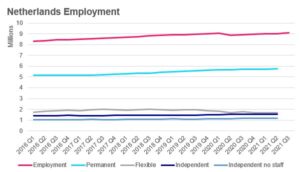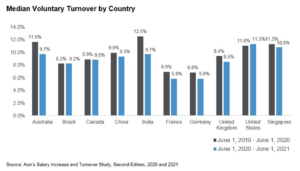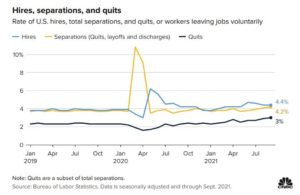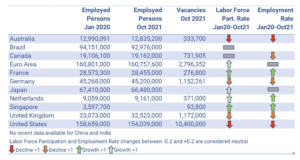
The Great Resignation.
The Great Realization. The Great Reimagination. The Great Reassessment. The Great Reshuffle. The Great Enlightenment.
You’ve seen the headlines and read the articles. Workers have had enough. They are exhausted and quitting their jobs. They leave the labor market and are not coming back. From now on, they work for themselves.
It all began with a March 2021 study from Microsoft that found “over 40 percent of the global workforce consider leaving their employer this year”. They indicated an intent to resign. The survey attracted a lot of attention around the world. Magazines and HR companies released surveys that all seemed to indicate that workers had enough and would shortly resign.
When the March and April U.S. Job reports came out, the numbers seemed to verify what Microsoft had concluded. In an interview with Bloomberg, Associate Professor Anthony Klotz of Texas A&M University used the term “The Great Resignation” to describe what was happening: people were quitting their jobs, and rethinking their work-life balance as a result of the pandemic. Or left due to reasons like health concerns or having to care for dependents.
The intent had become reality: people were quitting in numbers never seen before. And leaving the workplace. But my research shows that is happening only in America. And in larger, but not in huge numbers. It doesn’t occur anywhere else.
And what we are really seeing is a Great Return.
The problem with workforce surveys
I want to wash my car. But I don’t have time today. And I’m busy tomorrow. I’ll do it next week. When I probably don’t have plans (yet). You get my point: just because I intend to do something, doesn’t mean I will do it.
I’ve addressed the problem with workforce surveys before. The headlines make sweeping generalizations about the workforce, yet the underlying data is seldom representative.
I’ve also written about the fact that as we are moving from the Industrial Age to the Age of Intelligence, labor markets will struggle with demographic issues (as a result of Baby Boomers retiring) and skills mismatches more than anything else. Add the missing workers as a result of the pandemic and you have the perfect storm.
I had planned to look at the data supporting the Great Resignation for a while, but I never took the time (yes, great intentions!). Until a question from Wouter van Noort triggered me into action and I looked up resignation data for the Dutch labor market. And because the outcome was surprising, I looked at other countries too. What did I find?
Dutch employment is booming
With 126 vacancies per 100 unemployed people in the 3rd quarter of 2021, the Netherlands seem a prime candidate for the Great Resignation. Are people taking advantage of it?

Source: cbs.nl
Employment in the Netherlands saw a slight dip during the pandemic, but the number of employed people is now higher than ever before. Permanent employees saw the highest growth (+100.000 since Q1 2020), while independents added 91.000 (this includes part-time independents and side gigs).
At the start of the pandemic, the Dutch government made salary subsidies available to companies with the stipulation that they could not fire anyone. In addition, they hired people for testing and vaccination activities. This partially explains the growth of the labor market. But growth is also driven by the rebounding economy.
Eventually these “pandemic hires” will have to be absorbed by the regular labor market. But with more than enough vacancies, that currently doesn’t seem to be an issue (with the pandemic as unpredictable factor).
Now you could argue that the Great Resignation isn’t just about employment. It’s also about the resignation rate. So, I looked at that too. The Dutch Statistics Bureau doesn’t track the reason why people are quitting. But it does track professional changes: how many people change jobs, and if they remain in the same professional class (e.g. permanent to permanent) or switch between (e.g. permanent to independent).

In the middle of a Great Resignation, you would expect to see an increased rate of job changes. Which isn’t the case, as the dotted line in the chart shows. It is back to just under 3%, below the level before the pandemic. People are mostly switching from flexible to permanent status (different class). The rate of people leaving the workforce (mostly retirement) is also in line with earlier trends.
Dutch workers don’t seem to embrace the Great Resignation. But that might just be a coincidence. So let’s look at some other countries.
Global resignations are flat
The easiest way to assess if countries are in the middle of a Great Resignation, would be to look at the Quit rates and their reasons. Unfortunately, countries report labor market numbers in different ways (employee rate vs labor force participation), and very few include Quit rates. So I also looked at absolute growth and job-switching data (see also the table later in this article).
Here are a few examples (using the latest information available):
Australia – Labor force participation is at 64.7% as unemployment is rising (5.2%). In the year to February 2021 the proportion of Australian workers switching jobs fell to an all-time low: 7.6% of employed Australians changed jobs in the last year, down from a peak of 19.5% in 1988-89.
Canada – Labor force participation stands at 65.3% in Oct 2021, which is in line with pre-pandemic levels at 65.5%. The job-changing rate (which measures the proportion of workers who remain employed from one month to the next but who change jobs between months) was 0.7% in October, compared with 0.6% in September. Prior to the COVID-19 pandemic, the job-changing rate averaged 0.7%. It’s also interesting to note that since October 2019, the number of self-employed workers declined (-52,000; -11.0%) while the number of employees has increased (+191,000; +17.8%), entirely among those with a permanent work arrangement.
France – The employment rate increased to 67.5%, above its pre-crisis level by 0.7 points. Unemployment was stable and the activity rate rose to 73.5% and exceeded its pre-crisis level by 0.7 point. More people are back in the labor market than before the pandemic.
Spain – The employment rate is 50,5% up from 49,8% pre-pandemic. The absolute number of people in the labor market exceeds 20M and is the highest ever. Spain is executing a labor reform that classifies more gig workers as employees.
United Kingdom – The employment rate stands at 75.4%. In the latest quarter, the increase in employment was driven by a record high net flow from unemployment to employment of 304,000 people. Total job-to-job moves increased to a record high of 979,000 (appr 3%), largely driven by resignations, and is in line with pre-pandemic levels. The number of job vacancies in August to October 2021 continued to rise to a new record of 1,172,000.
And before you think that every country in the world is on the road to recovery, let’s look at some other countries and regions:
Latin America and the Caribbean – The economic recovery in Latin America and the Caribbean is still insufficient to recuperate the jobs lost during the pandemic. Between the first quarter of 2020 and the same quarter of 2021, there was an average reduction of 3.5 percentage points in the employment rate.
Nigeria – Countries in Africa suffer from a completely different crisis: youth unemployment. Less than half of Nigeria’s labor force is fully employed. More than 60% of Nigeria’s working-age population is younger than 34. Unemployment for people aged 15 to 24 stood at 53.4% in the fourth quarter of 2020, and at 37.2% for people aged 25 to 34.
A note on China & India – China & India don’t yet have 2021 job data available. India is reporting increasing turnover between companies, but it is mostly limited to white-collar jobs. For the quarter ending September 2021, many IT firms had a higher than 20% attrition rate. These workers don’t leave the workplace, they are accepting jobs at different companies, mostly to access better benefits and flexibility.
The Great Resignation isn’t so Great
Back in 2019, the global labor market was at an all-time high. Some countries are close to that level and for them, the pandemic is starting to look like a temporary setback. Economies are recovering with labor markets in full swing.
And my research shows that while people feel confident enough to switch jobs, they are not turning their back on employers. They are not becoming full-time independents. They are also not switching in larger numbers than before the pandemic: the highest resignation rates are around 3%. I’ve checked the National Statistics Bureaus of dozens of countries and have not seen any statistics that indicate that. It’s mostly back to business as usual.
One of the most interesting findings was that even the countries with high numbers of vacancies, like Belgium, Germany, the Netherlands and the United Kingdom, don’t have higher job switch rates than they had in 2019. Workers are not leaving the workforce in high numbers other than for regular reasons like retirement or becoming an independent.
The Great Resignation isn’t Global
Someone said: “This trend is most pronounced in the US.” Based on the data, it’s the only country in the world with this trend. The Great Resignation is an American phenomenon. I’ve not found another country with the same dynamic.

My observations are supported by a recent study from Aon that compares voluntary turnover for 2020 and 2021. Aon concluded that global turnover is mostly flat or declining: “In the past year, the U.S. experienced a modest increase in turnover while Australia, China, India, France, Germany and Singapore experienced declining turnover. Other countries were mostly flat.” The study ended June 2021 and did not take recent U.S. data into account.
The Great Resignation is American. Or is it?
With more jobs than workers, the American labor market is experiencing a change from a decades long status quo, where it was exactly the opposite. A record number of 10M jobs are available. The number of people quitting is up as well. In theory, this should be a good thing.
The general perception is that people are voting with their feet and leaving the workplace: the Great Resignation. But keep in mind that in March and April of 2020 more than 22M workers were laid off or discharged in the U.S. It’s the yellow spike in the chart below.

Between 2016 and 2020, the average separation rate in the US was 3.9%. So far in 2021, it’s 3.9% as well. Layoffs and discharges are down 40% in 2021 compared to the 5 years prior. The average 2021 quit rate is 2.6%, up from a 2.2% 5-year average. Could the thorny issue be who is doing the quitting?
Derek Thompson wrote in the Atlantic: “The truth is people in the 1960s and ’70s quit their jobs more often than they have in the past 20 years, and the economy was better off for it.” And when you compare it to other economies, a quit rate of 3% doesn’t seem excessive, as long as people don’t leave the workforce.
Goldman Sachs’ economists analyzed the separation numbers and concluded that people are not leaving because they are fed up. Out of 5M leavers they looked at, 3.4M were over 55 years old. 1M retired, and an additional 1.5M opted for early retirement. While that provides a more nuanced view, it still means that 2.5M workers left the labor force.
Data from the Bureau of Labor Statistics shows a steady rise in the employed-to-employed rate, which indicates that people are back to job switching, and not leaving the labor market in record numbers like they did last year (voluntary or involuntary).
With 10 million vacancies available, Danny Nelms, president of the Work Institute, said in the WSJ: “Many workers have a rare edge: Jobs are plentiful, wages are rising, and companies are competing for talent.” So, if you have the chance, why wouldn’t you switch to a better job?
Resignation or Hesitation?
Why is this happening in the United States and not anywhere else? I am not an expert on the American labor market, so I’ll leave the explanations to those who are better informed:
In the New York Times, Paul Krugman suggested that America is witnessing a worker revolt in the wake of years of substandard conditions. Workers are using growing job openings to look for better or less demanding jobs or are simply retiring early.
When asked about the difference between the European and American labor market he commented: “Could be European reliance on job retention schemes rather than unemployment insurance. Could be that European work conditions for low-paid workers were better to begin with?”
Economists at Barclays led by Michael Gapen disagree. They say what’s going on is more of a “Great Hesitation”. They wrote: “We believe that this (American) resignation dynamic is mostly a symptom of other underlying forces that are affecting labor market participation, rather than a cause. Instead, the true cause is a hesitation of workers to return to the labor force, due to influences tied to the pandemic such as infection risks, infection-related illness, and a lack of affordable childcare.”
Economist Daniel Alpert, who publishes the Job Quality Index, an economic indicator that tracks the ratio of attractive, high-paying jobs and low-wage, low-hour roles, has a different view. Workers who left retail, leisure and hospitality, and social assistance jobs typically earned more from enhanced UI than their past salaries, according to Alpert. He points at the $5 trillion that the U.S. government spent in pandemic-era stimulus, which gave many low-paid Americans a financial buffer: “Once that buffer runs out, those people will return to the workforce and power a hiring frenzy”.
The unique American situation
The pandemic drove down labor force participation rates around the world. Some countries have succeeded in bringing the labor force participation back to its pre-pandemic level, or even higher.
The Euro Area and France are examples of that, as the chart below shows (country selection based on Aon chart above). Germany and the United Kingdom are close to pre-pandemic levels. But the Euro Area shouldn’t feel too comfortable though: It is facing demographic shifts that will decrease the available workforce with no good solutions in sight.

See footnote for methodology
In many developed countries, people have benefited from government support for businesses and an economic recovery which have helped drive the unemployment rate down. In Europe, companies received financial aid from the government, to help them retain existing staff. Which means companies didn’t fold, and people remained in their positions. Governments didn’t provide benefits to individuals unless they already received unemployment. (And to be clear: social security does not kick in when you resign voluntarily.) The longer the pandemic lingers, the less likely it is we’ll see a Great Resignation occur here.
In the US, labor force participation is down close to 2 points since January 2020 (63.4 to 61.6) and the employment rate fell from 61.1 to 58.8. The absolute number of people in the workforce is 4.6M lower than it was before the pandemic. And with 10M vacancies to fill, the American workforce would not only have to grow back to pre-pandemic levels, it would also have to add 5M workers. With many states reporting record low unemployment numbers that seems impossible to achieve in the short term.
And that means when vacancies go up, employers are faced with low workforce availability. The tight supply of workers gives employees greater choice and “buying power”. When they apply for a new job, they are able to negotiate higher wages, better benefits and work arrangements. It also means they have options they never had before: the ability to choose between multiple employers and create a bidding war. Despite a rising number of vacancies, this dynamic doesn’t play out in other countries.
It’s the perfect storm. Low labor market participation and a high number of vacancies, combined with an inability to bring people back into the workforce quickly enough to fill them seems a unique situation. It might even begin to explain why the Great Resignation is an American phenomenon.
The Great Return
There is no Great Resignation. People are not leaving the workplace in record numbers. You could just as easily argue that it’s pent-up demand and employers held on to employees longer because of the pandemic. Or that they were quick to let them go.
The vast majority of people who resign, remain in the same industry. They switch to improve their work circumstances: better salaries, benefits and more autonomy and flexibility. Employers who can offer that have an advantage. But that was always the case.
With the recently discovered new variant, the pandemic is far from over. Asking people about their intentions in the midst of a global crisis is not the most reliable way to make generalizations about the labor market.
But because something isn’t true for the labor market as a whole, that does not mean a business can’t be impacted. While people might not be quitting in record numbers, an industry or business can still be affected by too many people leaving.
It’s devastating when a business owner can’t hire the people she needs – I’ve been there – and it’s detrimental to a company’s results and might even threaten its existence. Businesses die when they are unable to fulfill their vacancies. That’s why I recommend that you have a solid workforce strategy in place.
It’s even more important in light of two labor trends that are supported by data: demographics and skills. In several regions of the world, especially in Europe, more people will leave the workforce than enter it. The Age of Intelligence requires different skills sets, and people first must be reskilled, followed by continuous upskilling.
The Great Resignation isn’t happening today. Instead, we’re seeing a Great Return of people to the workplace. But consider it a wake-up call to bring your work practices in line with the needs and wishes of the 2025 workforce. It might just make the difference between surviving and thriving in the future of work.
Labor indicators:
When the number of Employed Persons increases, that is an indicator of a growing workforce. However, if a country’s labor force increases at the same time because more people enter the workforce, it’s not a complete view. That why I also looked at the Employment Rate and the Labor Force Participation Rate. When all 3 indicators go up or are neutral, the workforce is growing in absolute and relative numbers or stable, and people are not leaving the workforce.
Employed Persons: All persons of working age who during a specified period were in the following categories: paid employment or self-employment, at work, or temporarily not at work for any specific reason.
Employment Rate: Measures the number of people who have a job as a percentage of the working age population.
Labor Force Participation Rate: The labor force participation rate is an estimate of an economy’s active workforce. The formula is the number of people ages 16 and over who are employed or actively seeking employment divided by the total non-institutionalized, civilian working-age population.
Open Vacancies: The number of open vacancies listed by a country’s National Statistics Bureau.
Period: January 2020 to October 2021
Data sources used:
| Australia | https://www.abs.gov.au |
| Canada | https://www.statcan.gc.ca |
| Euro Area | https://ec.europa.eu/eurostat |
| France | https://www.insee.fr/en/accueil |
| Germany | https://www.destatis.de |
| Japan | https://www.stat.go.jp/english/ |
| Netherlands | https://www.cbs.nl |
| Singapore | https://www.singstat.gov.sg/ |
| United Kingdom | https://www.ons.gov.uk |
| United States | https://www.bls.gov |
| ILO | https://www.ilo.org |
| OECD | https://www.oecd.org |